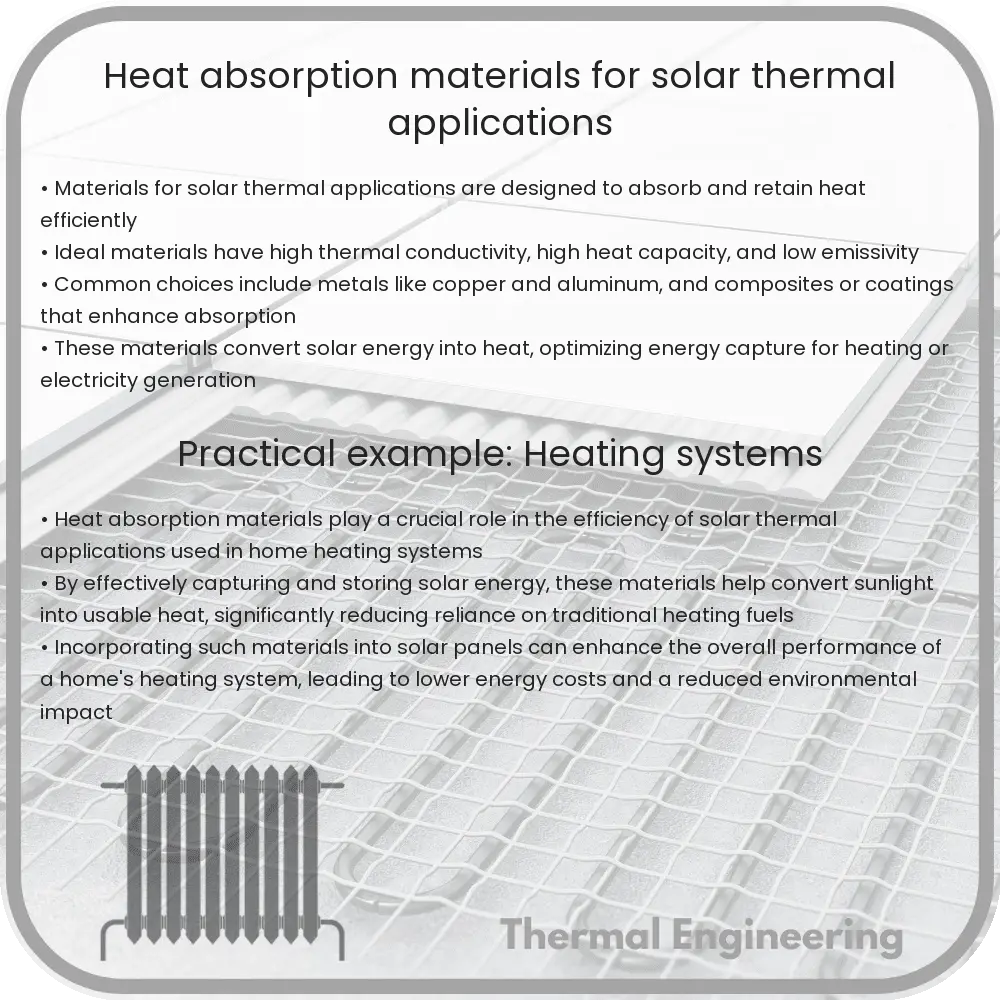Explore the properties and applications of materials used for heat absorption in solar thermal technologies, focusing on efficiency and durability.

Understanding Heat Absorption Materials for Solar Thermal Applications
Solar thermal technologies are a cornerstone of renewable energy solutions, tapping into solar energy to generate heat instead of electricity. At the heart of solar thermal systems are materials that absorb heat from sunlight effectively and efficiently. The choice of these materials is crucial for optimizing performance, cost, and durability. This article explores the various types of heat absorption materials used in solar thermal applications and discusses their properties and uses.
Criteria for Heat Absorption Materials
The efficiency of a solar thermal system largely depends on the ability of its heat absorption materials to collect and convert sunlight into usable heat. Essential criteria for these materials include:
- High solar absorbance: The ability to absorb a high percentage of incident solar radiation.
- Low thermal emittance: The ability to retain the absorbed heat and minimize heat loss by radiation.
- Durability: Resistance to high temperatures, corrosion, and UV degradation over long periods.
- Cost-effectiveness: Affordable for manufacturing and maintenance, considering overall system efficiency and lifespan.
Common Heat Absorption Materials
Several materials meet these criteria to varying degrees, each offering unique benefits and challenges. The most common types include:
- Metallic Absorbers: Metals like copper and aluminum are frequently used due to their high thermal conductivity, which helps in the efficient transfer of heat. These are often coated with selective surface coatings to enhance solar absorbance and reduce emittance.
- Paints and Coatings: Specialized black or selective paints are applied to absorber surfaces. These materials are easy to apply and relatively inexpensive but generally have lesser performance in terms of durability and thermal properties compared to other materials.
- Ceramics: Advanced ceramics can withstand very high temperatures and aggressive environmental conditions, making them ideal for high-temperature applications.
- Phase Change Materials (PCMs): PCMs absorb and store heat by changing phase (e.g., from solid to liquid). They are particularly useful in systems requiring thermal energy storage to provide heating or cooling at different times.
Selective Surface Coatings
One significant advancement in material technology for solar thermal systems is the development of selective surface coatings. These coatings are designed to maximize solar absorbance while minimizing thermal emittance.
Common types of selective coatings include:
- Black chrome: This is highly absorptive and can resist high temperatures, but may degrade under UV exposure.
- Anodized aluminum: Durable and resistant to corrosion, this material slightly underperforms in terms of solar absorbance compared to black chrome.
- Cermet (ceramic-metal composite): These materials incorporate properties of both ceramics and metals, offering excellent durability and thermal properties.
Applications of Heat Absorbing Materials
Heat absorption materials find applications in various types of solar thermal systems, including:
- Solar water heaters: Typically used in residential and commercial settings for heating water.
- Concentrated Solar Power (CSP) systems: Employing mirrors or lenses to concentrate a large area of sunlight onto a small absorber, these systems often use advanced materials capable of withstanding very high temperatures.
- Solar air heaters: Used for heating air in residential, commercial, or industrial settings.
Advancements in material science continue to push the boundaries of what is possible in solar thermal technology, making it a continually evolving and exciting field of study and application in renewable energy.